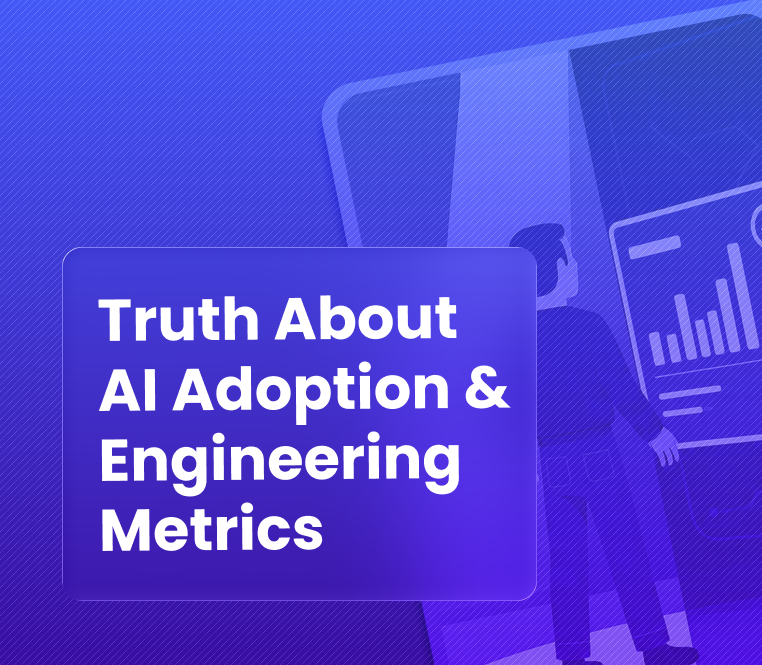How Gut-based Decisions Prove Costly
When you can’t gauge software development productivity and outcomes, you don’t know where you stand against competitors, nor demonstrate the progress of the team to peers, management nor direct reports. Just like you cannot know how fast or slow you're driving without using a speedometer. With the businesses being very agile, engineering is expected to be agile where decision-making is vital. In such situations where you want to make decisions, gut-based decisions can prove costly in lost opportunities, time and money.
Data-driven engineering enables:
• Not relying on guesswork or gut feelings to drive strategic business decisions. Instead, using clean, clear, and concrete insights from data gathered directly from engineering tools.
• Improving the visibility of data and insights for engineers at every software development life cycle stage to comprehend and optimize performance based on data.
• Optimizing the cost of software development by plugging in loopholes in terms of tech debt and managing resources better.
…and saves companies from making expensive, ineffective decisions.
The future of performance management is more data-driven, flexible, continuous, and development-oriented, according to McKinsey, as organizations move past the excessively subjective, confusing, and unhelpful ways of measuring employee performance based on guesswork or gut feeling.
The Importance of Objectivity in Software Engineering
Software quality can be differentiated internally and externally. Customers might see what makes a software product high-quality externally, but can’t differentiate between higher or lower quality internally. Not right away, anyway.
Martin Fowler makes a case for high-quality software appealingly. Cruft is the term used to name the difference between the current code and how it would be ideally. If a software code is neatly divided into modules and is clean and easy to follow, it can be revised and comprehended by succeeding developers.
Since customers care that new features are made available ASAP, internal quality makes its case. And so does having the ability to measure it objectively.
Objectivity in software development allows leaders to:
- Measure software development performance
By quantifying software development performance, engineering leaders can compare data points such as DORA metrics against global benchmarks and position their efforts in the competitive landscape. You can’t improve what you don’t measure.
- Recognize loopholes in optimum performance and efficiency
When engineering teams experience halted performance, engineering leaders can turn to objective data to interpret gaps and plug them in. Data-driven engineering enables dynamically reading data and aggregating it in new ways into a clean dashboard to gain insights into team productivity and performance.
- Make data-driven decisions
Visually comparing data opens up avenues for communication, collaboration, and correction. If there are areas in your development team that require attention or resources, insights from data show them. Using data to challenge or adopt decisions is a powerful way to move engineering functions forward.
Objective Measurement - Engineering Vs. Sales and Marketing
Engineering metrics are elusive, which makes quantifying software development impossible. What is the measure of an effective software development process? How do you identify an elite software engineering team?
In stark contrast to sales and marketing departments identifying KPIs, engineering teams fall short and risk failure. Also, it’s humorous to note that engineering teams that fall short of goals don’t know that they have- due to a lack of quantification. You don’t know when you’ve succeeded, and you don’t know when you’ve fallen short.
Healthy engineering metrics should establish agreed-upon standards, make quantification easy and accessible, and help optimize code production at high quality.
Research by Stripe shows that while the number of developers is increasing year on year at most companies, what’s most important is how they are being leveraged. When their skills are utilized effectively it helps companies differentiate themselves and even enter new markets or product lines. Hivel collects data from developer tools and offers actionable insights in interactive dashboards to facilitate quicker releases, better quality, and increased throughput.
The Importance of Data-driven Engineering
What engineering leaders don’t know can hurt their teams and the company. Data can provide visibility into the working of development teams and engineering processes. It can also reveal where in the process effort is being lost and where one can find efficiency gains
Data also provides potent insights into helping engineering teams improve performance, untangle bottlenecks in the process, leading indicators into software delivery signals, team burnout, and more.
Data-driven engineering uses data from tools that engineering teams use on an everyday basis, such as version control tools like Bitbucket, GitHub, and GitLab or project management tools like Jira to help optimize the productivity of software engineers, which directly benefits the engineers, customers, and the business.
Leverage real-time engineering data for modern data-driven engineering managers with Hivel.
Request a demo or try Hivel for free today.
Also, read: DORA metrics explained: The Major Metrics for Engineering Productivity
The Importance of Data-driven Engineering
What engineering leaders don’t know can hurt their teams and the company. Data can provide visibility into the working of development teams and engineering processes. It can also reveal where in the process effort is being lost and where one can find efficiency gains
Data also provides potent insights into helping engineering teams improve performance, untangle bottlenecks in the process, leading indicators into software delivery signals, team burnout, and more.
Data-driven engineering uses data from tools that engineering teams use on an everyday basis, such as version control tools like Bitbucket, GitHub, and GitLab or project management tools like Jira to help optimize the productivity of software engineers, which directly benefits the engineers, customers, and the business.
Leverage real-time engineering data for modern data-driven engineering managers with Hivel.
Request a demo or try Hivel for free today.
Also, read: DORA metrics explained: The Major Metrics for Engineering Productivity














